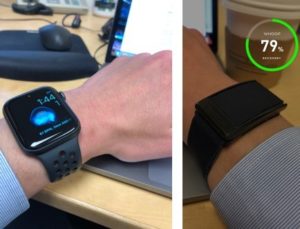Much of the “buzz” in the air among ACC19 attendees revolved around the Apple Heart Study. There was a wide variety in reactions to the study results – from underwhelmed to measured to overzealous. After some reflection, my personal reaction is that I’m just glad this study was performed – now we have some data for one of the most widely used wearable devices by our patients. Patients will, and already have, come to me with questions about the Apple Watch and its heart rhythm monitoring capabilities, and now I have some numbers available to help me address their concerns.
As the Apple Heart Study is likely just the beginning of an impending flood of wearable and virtual enrollment studies, physicians will undoubtedly be asked more and more questions about data collected by our patients’ devices. Just the other week in clinic, I had one new patient present with concerns about his cycling performance over the past few months. I fortunately noticed he was wearing an Oura ring device, and I asked him if he wore the ring during his cycling rides. He was shocked – he had yet to encounter a physician who knew what the Oura ring was, let alone be comfortable with analyzing the variety of data it measured. Fortunately, I had just chatted at length with a colleague who uses the Oura ring, as I was in the market for a wearable fitness monitor at the time. Yet even my cursory knowledge of the device seemed to deepen the patient-physician relationship in that first clinic visit.
The primary objective of the Apple Heart Study was to test the ability of the Apple Watch and its rhythm analysis algorithm to accurately detect atrial fibrillation. While atrial fibrillation detection is clearly an important tool, as recently described by AHA blogger, Dr. Christa Trexler, there are a variety of data being collected by wearables that may have tremendous value for our ability to optimally care for our patients, as these measurements lend insight into the 99+% of the time our patients spend outside of our clinic room with us. These include routinely measured factors (such as heart rate, step counts, and even blood pressure), but they are also measuring parameters and providing assessments of factors we do not routinely use in clinical practice, such as heart rate variability (HRV), “sleep quality,” and recovery/readiness indices. So, should we start incorporating these latter measurements in our patient care?

Figure: (Left) Apple Watch Series 4. (Right) Whoop Strap 2.0, demonstrating my Recovery Score for the day (based on my recent sleep patterns and recent cardiovascular workloads). (Both) Demonstration of probably wearing too many wearable devices.
As I mentioned, I was in the market for a wearable device, and somehow I now have two: the Apple Watch Series 4 and the Whoop Strap 2.0 (Figure 1). Overkill? Absolutely. But in experimenting with these devices, I’ve become incredibly fascinated with the HRV, sleep quality scores, and recovery. These are metrics that counterbalance our typical recommendations of increased physical activity with adequate rest and recovery. However, while parameters such as HRV were heavily studied in the 1990s and remain very much present in the current literature (search for “heart rate variability” on Pubmed yields 1665 publications), we have not routinely interfaced with these parameters in modern cardiology practice.
Yet I’ve found myself poring over my own device-measured physiological data and have already used it to plan my days. For instance, when my Whoop strap notifies me that I’m “in the green” and adequately recovered (as in Figure 1), I plan a more intense workout. Conversely, when I haven’t had adequate sleep for consecutive nights, I will be reminded by the Whoop app that my body is not primed for significant strain, and I will focus my efforts on restorative exercises, such as stretching and an early bedtime. While it seems silly to rely on a device to tell me how my body should feel, it has at the very least strengthened my own practice of reflecting on my health daily, a practice that can easily be forgotten amid busy clinical and research training.
With the increasing popularity and use of these wearables, and now that Apple Heart Study has paved the way for massive amounts of patients to be enrolled in studies using wearables, more of our patients will be using the Apple Watch, the Whoop strap, and other similar devices. To better prepare for this inevitable influx of personalized data, I feel that it is useful for clinicians to have our own experiences with these devices and apps. In my own experience, I’ve seen it enhance clinic encounters with patients, and by learning more about how devices monitor my own physiology, I believe it can help me better counsel my patients on how to monitor theirs.
What wearables do you use? Has your own use of wearables already impacted your management of patients? Would love to hear your thoughts via Twitter @JeffHsuMD.